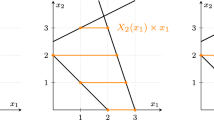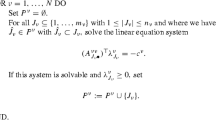Abstract
We present a mixed-integer model to optimize a competitor’s behavior in a network revenue management game. Our model is based on a well-known deterministic linear program for the single-airline network revenue management problem. Assuming that the competitors make decisions based on our model, we present an algorithm to compute a pure Nash equilibrium (NE) in a two-player game through an iterative search for best responses. If the algorithm gets stuck in a loop without finding an NE, additional constraints are added to the models to control the search. The complete algorithm finds an NE with certainty if one exists in the game. The players’ price vectors are modified so that their models have unique solutions, and the search follows a unique path. This makes sure that both players end up in the same NE even if uniqueness is not guaranteed or cannot be proved. A computational study shows the algorithm’s performance which can compute NE in networks of realistic size in acceptable time.









Similar content being viewed by others
References
Audet C, Hansen P, Jaumard B, Savard G (2001) Enumeration of all extreme equilibria of bimatrix games. SIAM J Sci Comput 23(1):323–338
Çetiner D, Kimms A (2013) Assessing fairness of selfish revenue sharing mechanisms for airline alliances. Omega 41(4):641–652
Charnes A (1952) Optimality and degeneracy in linear programming. Econometrica 20(2):160–170
Chen X, Deng X, Teng SH (2009) Settling the complexity of computing two-player Nash equilibria. J Assoc Comput Mach 56(3):1–57
Daskalakis C, Papadimitriou CH (2006) Computing pure Nash equilibria in graphical games via Markov random fields. In: Feigenbaum J (ed) Proceedings of the 7th ACM conference on electronic commerce. ACM Press, New York, pp 91–99
Daskalakis C, Goldberg PW, Papadimitriou CH (2006) The complexity of computing a Nash equilibrium. In: Kleinberg J (ed) Proceedings of the 38th annual ACM symposium on theory of computing. ACM Press, New York, pp 71–78
de Boer SV, Freling R, Piersma N (2002) Mathematical programming for network revenue management revisited. Eur J Oper Res 137(1):72–92
Deutsche Lufthansa AG (2016) Financial statements 2016. https://investor-relations.lufthansagroup.com/fileadmin/downloads/en/financial-reports/financial-statements/LH-FS-2016-e.pdf. Accessed 31 Aug 2017
Echenique F (2007) Finding all equilibria in games of strategic complements. J Econ Theory 135(1):514–532
Fudenberg D, Tirole J (1991) Game theory. MIT Press, Cambridge
Gao H, Ball MO, Karaesmen IZ (2010) Competitive seat inventory control decisions under the regret criterion. J Revenue Pricing Manag 9(1–2):49–65
Graf M, Kimms A (2011) An option-based revenue management procedure for strategic airline alliances. Eur J Oper Res 215(2):459–469
Graf M, Kimms A (2013) Transfer price optimization for option-based airline alliance revenue management. Int J Prod Econ 145(1):281–293
Grauberger W (2015) Network revenue management under competition within strategic airline alliances. Ph.D. thesis, University of Duisburg-Essen, Duisburg
Grauberger W, Kimms A (2014) Computing approximate Nash equilibria in general network revenue management games. Eur J Oper Res 237(3):1008–1020
Grauberger W, Kimms A (2015) Airline revenue management games under simultaneous price and quantity competition. Technical report, University of Duisburg-Essen, Duisburg
Grauberger W, Kimms A (2016) Revenue management under horizontal and vertical competition within airline alliances. Omega 59(Part B):228–237
Harks T, Hoefer M, Klimm M, Skopalik A (2010) Computing pure Nash and strong equilibria in bottleneck congestion games. In: Berg M, Meyer U (eds) Algorithms ESA 2010, vol 6347. Lecture notes in computer science. Springer, Berlin, pp 29–38. https://doi.org/10.1007/978-3-642-15781-3_3
Harsanyi J, Selten R (1988) A general theory of equilibrium selection in games. MIT Press, Cambridge
Jiang AX, Leyton-Brown K (2007) Computing pure Nash equilibria in symmetric action graph games. In: Proceedings of the twenty-second AAAI conference on artificial intelligence. AAAI Press, Menlo Park, pp 79–85
Jiang H, Pang Z (2011) Network capacity management under competition. Comput Optim Appl 50(2):287–326
Kimms A, Çetiner D (2012) Approximate nucleolus-based revenue sharing in airline alliances. Eur J Oper Res 220(2):510–521
Lemke CE, Howson JTJ (1964) Equilibrium points of bimatrix games. J Soc Ind Appl Math 12(2):413–423
Li MZF, Oum TH, Anderson CK (2007) An airline seat allocation game. J Revenue Pricing Manag 6(4):321–330
Li MZF, Zhang A, Zhang Y (2008) Airline seat allocation competition. Int Trans Oper Res 15(4):439–459
McKelvey RD, McLennan A (1996) Computation of equilibria in finite games. In: Amman HM, Kendrick DA, Rust J (eds) Handbook of computational economics, vol 1. Elsevier, Amsterdam, pp 87–142. https://doi.org/10.1016/S1574-0021(96)01004-0
Murty KG (1983) Linear programming. Wiley, New York
Nash JF (1950) Equilibrium points in n-person games. Proc Natl Acad Sci USA 36(1):48–49
Netessine S, Shumsky RA (2005) Revenue management games: horizontal and vertical competition. Manag Sci 51(5):813–831
OneWorld (2014) Member airlines. http://www.oneworld.com/member-airlines/overview. Accessed 1 Aug 2014
Oum TH, Park JH (1997) Airline alliances: current status, policy issues, and future directions. J Air Transp Manag 3(3):133–144
Panagopoulou PN, Spirakis PG (2006) Algorithms for pure Nash equilibria in weighted congestion games. J Exp Algorithm 11:1–19
Ryan CT, Jiang AX, Leyton-Brown K (2010) Computing pure strategy Nash equilibria in compact symmetric games. In: Proceedings of the 2010 ACM conference on electronic commerce. ACM, New York, pp 63–72
SkyTeam (2014) Skyteam members. http://www.skyteam.com/en/About-us/Our-members/. Accessed 1 Aug 2014
StarAlliance (2014) Member airlines. http://www.staralliance.com/en/about/member_airlines/. Accessed 1 Aug 2014
Talluri KT, van Ryzin G (2004) The theory and practice of revenue management. Kluwer Academic Publishers, Boston
von Stengel B (2007) Equilibrium computation for two-player games in strategic and extensive form. In: Nisan N, Roughgarden T, Tardos E, Vazirani VV (eds) Algorithmic game theory. Cambridge University Press, Cambridge, pp 53–78. https://doi.org/10.1017/CBO9780511800481.005
Williamson EL (1992) Airline network seat inventory control: methodologies and revenue impacts. Ph.D. thesis, Massachusetts Institute of Technology, Cambridge
Acknowledgements
This work was done with financial support from the German Research Foundation (DFG) under Grant No. KI 1272/2-2. We thank the area editor and two anonymous referees for useful comments about an earlier version of the paper.
Author information
Authors and Affiliations
Corresponding author
Appendix: Computational results for perturbation order “alphabetic by O&D name, then by fare class”
Appendix: Computational results for perturbation order “alphabetic by O&D name, then by fare class”
In the following we show the computational results for the instances with perturbation order “alphabetic by O&D name, then increasing by fare class.” Figures 10, 11, and 12 show the average computation times, while Figs. 13, 14, and 15 show the average iterations needed to reach an NE. As in the other perturbation order, there is a positive correlation between the computation time and number of iterations needed to reach an NE. The larger the networks and the higher the competition intensity, the more time and iterations were needed to find an NE.
Tables 9, 10, and 11 show the average payoff ratios. The higher the CI, the more it pays off to take competition into account. This circumstance is indicated by the shrinking ratio of NE and non-competitive payoffs (NC/NE). Tables 12, 13, and 14 represent the average payoff ratios with linear vs. algorithmic binary variables. Again, no definite statement can be made about which concept dominates which.
Rights and permissions
About this article
Cite this article
Grauberger, W., Kimms, A. Computing pure Nash equilibria in network revenue management games. OR Spectrum 40, 481–516 (2018). https://doi.org/10.1007/s00291-018-0507-5
Received:
Accepted:
Published:
Issue Date:
DOI: https://doi.org/10.1007/s00291-018-0507-5










